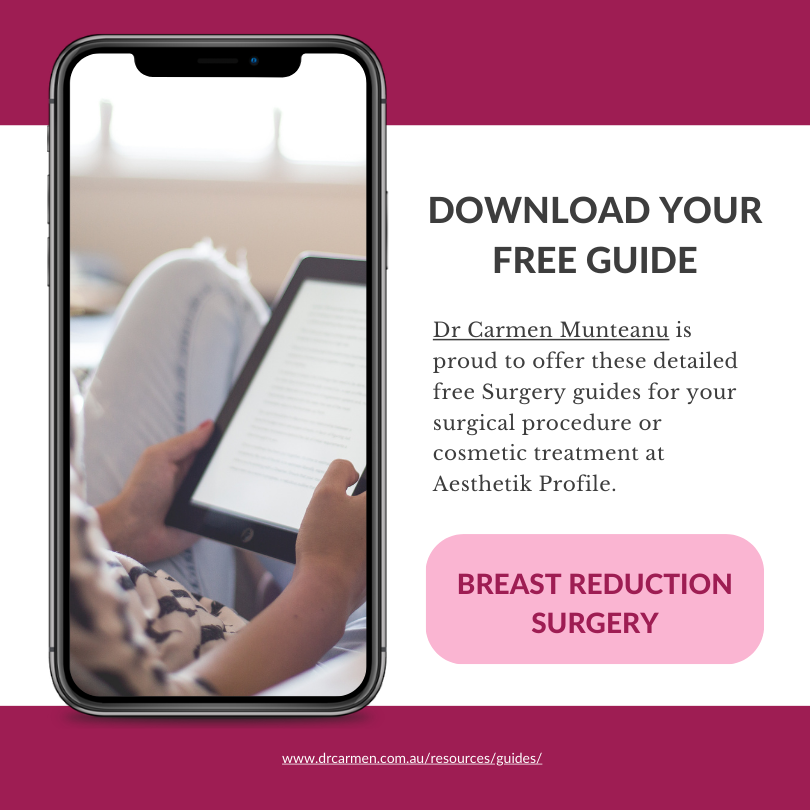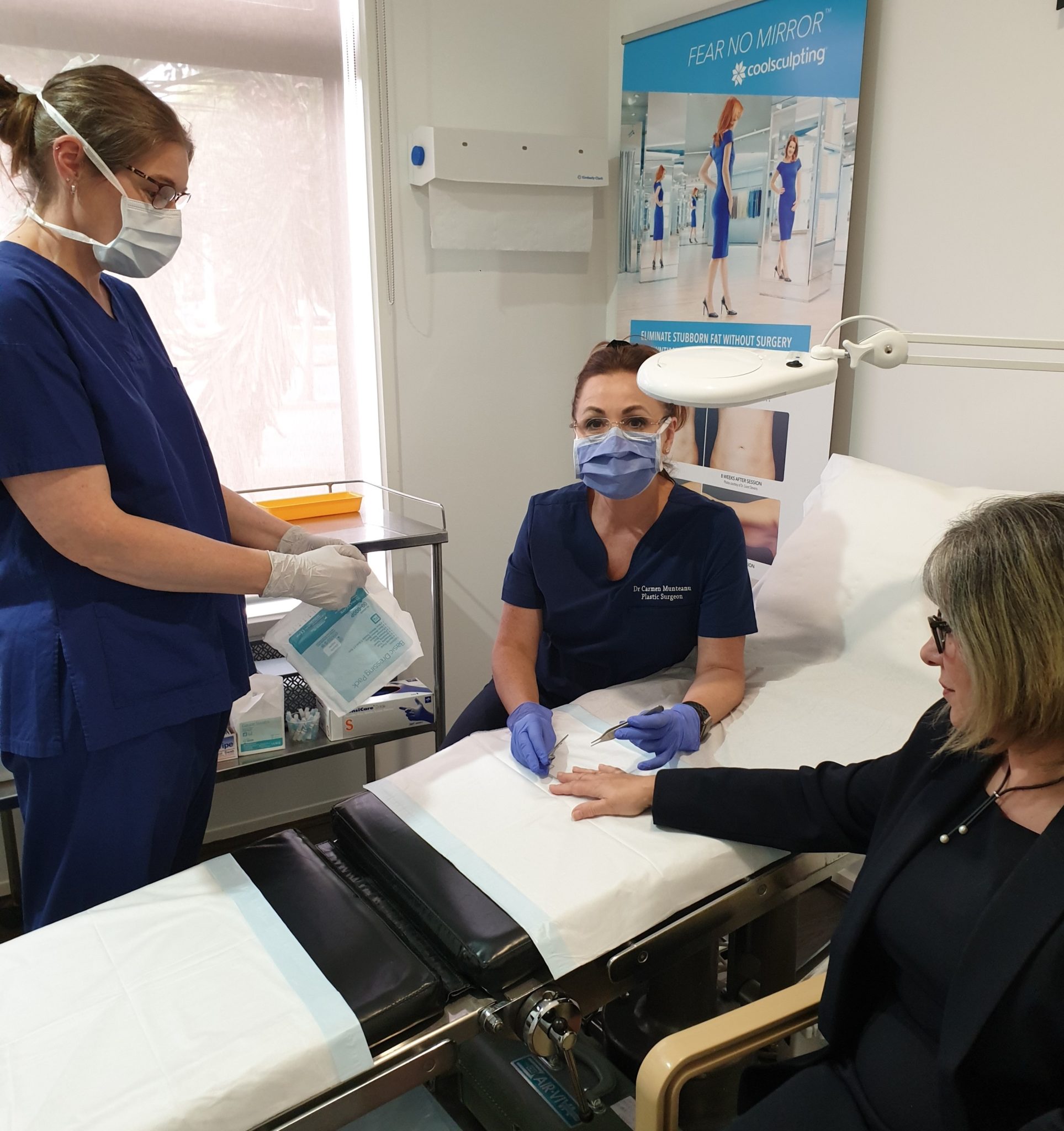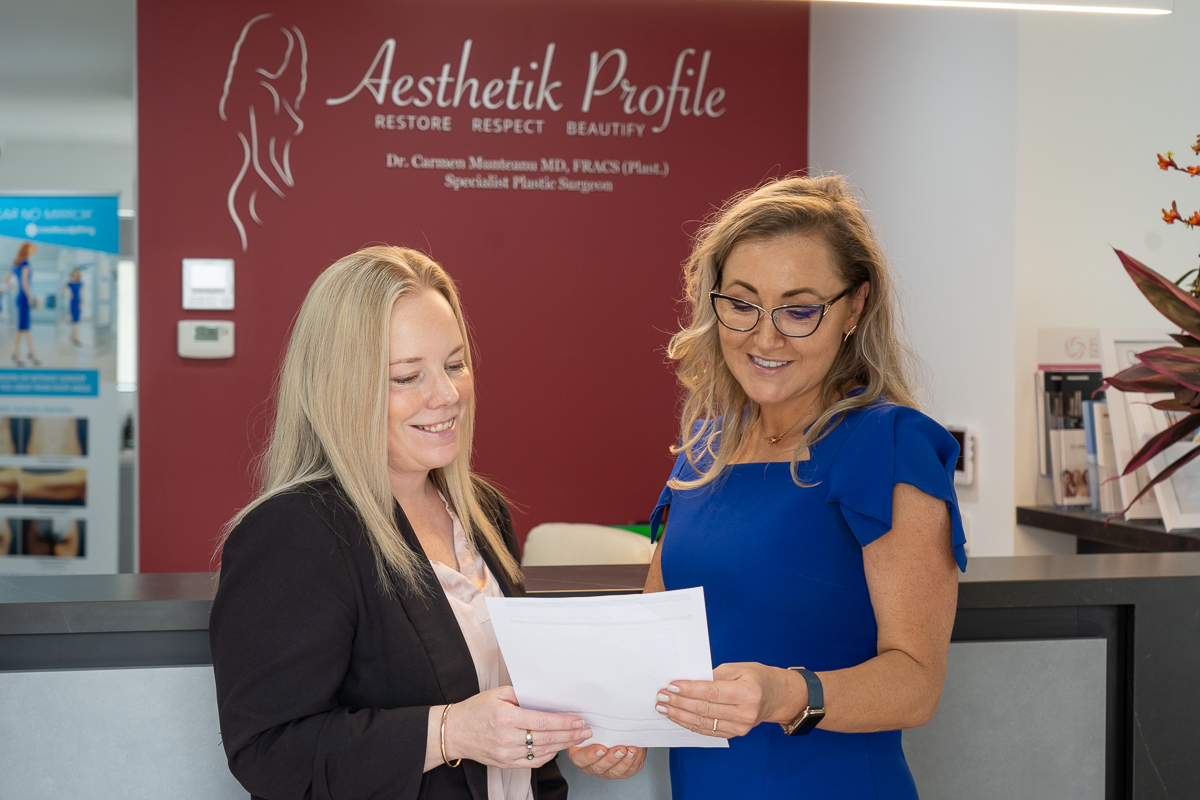Tips and Timeline for Resuming Exercise after Breast Reduction Surgery
Breast reduction surgery can alleviate discomfort associated with overly large breasts. The recovery process requires careful attention, particularly when it comes to resuming physical activity. This blog post will guide you through the key points of recovery, when to start exercising, what exercises to do, which ones to avoid, and when to stop exercising or contact your plastic surgeon.
Dr Carmen Munteanu is a Specialist Plastic Surgeon based in Melbourne’s eastern suburbs. She has a keen interest and extensive experience in plastic and reconstructive surgery. Dr Carmen approaches each case with empathy and compassion, precisely defining patient expectations and designing a specific plan for each individual.
Download Dr Carmen’s Guide to Breast Reduction Surgery – Reduction Mammaplasty

What Happens During Recovery after Breast Reduction Surgery
During the recovery period after a breast reduction surgery, several processes and stages occur:
- Initial Healing: In the first few days post-surgery, your body begins the healing process. You may experience swelling, bruising, and discomfort. You should rest and avoid any strenuous activities during this time
- Wound Care: Proper care of the surgical incisions is vital to prevent infection and promote healing. This includes cleaning the area as instructed by your plastic surgeon and possibly changing dressings
- Medication Management: You’ll likely be prescribed medications to manage pain and prevent infection. It’s important to take these as directed by your plastic surgeon
- Physical Changes: As the swelling subsides, you’ll start to see the new shape of your breasts. It’s important to note that final results may take several months as your body continues to heal and adjust
- Gradual Resumption of Activities: Over time, you can gradually resume daily activities and light exercises, as advised by Dr Carmen. This should be done slowly and carefully to avoid straining the healing tissues
- Regular Follow-ups: Regular follow-up appointments with Dr Carmen are essential to monitor your healing progress. Dr Carmen can address any concerns and guide you on the next steps in your recovery
- Emotional Adjustment: Along with physical healing, you may also go through an emotional adjustment period as you get used to your new body shape. It’s normal to have mixed emotions during this time
When to Start Exercising after Breast Reduction Surgery
Resuming exercise after breast reduction surgery is a gradual process and should be tailored to your individual recovery and overall health. Here’s a more detailed timeline:
- First Week: During the first week after surgery, it’s important to rest and allow your body to initiate the healing process. Any form of strenuous activity should be avoided. However, short, gentle walks around your home are encouraged to promote blood circulation and prevent blood clots
- 2-3 Weeks Post-Surgery: After about 2-3 weeks, you may be able to start incorporating light exercises into your routine. This could include longer walks, gentle stretching, and lower body exercises. It’s crucial to avoid any activities that cause pain or discomfort, particularly in the chest area
- 4-6 Weeks Post-Surgery: By this time, your body has likely healed significantly, and you may be able to resume moderate exercise. This could include cycling, swimming, or using an elliptical machine. However, you should still avoid exercises that put strain on your chest or upper body
- 6-8 Weeks Post-Surgery and Beyond: After about two months, most patients are fully healed and can resume all types of exercise, including upper body workouts. It’s important to start slowly and gradually increase intensity to avoid injury
These are general guidelines and the exact timeline can vary. Always consult with Dr Carmen before resuming or starting a new exercise regimen after surgery. She can provide the most accurate advice based on your personal recovery progress.
What Exercises Should You Do During Recovery after Breast Reduction Surgery
During the recovery period after breast reduction surgery, it’s important to gradually reintroduce physical activity into your routine. Here are some exercises that are generally safe to do at different stages of recovery:
- Walking: Starting from the first day after surgery, short, gentle walks can help promote blood circulation, reduce the risk of blood clots, and boost your mood. Gradually increase the length and intensity of your walks as your strength and energy levels improve
- Gentle Stretching: After a couple of weeks, you can start doing gentle stretching exercises. This can help maintain flexibility and range of motion. Be careful not to stretch your arms too high or do anything that strains your chest
- Lower Body Exercises: As you continue to heal, you can start incorporating lower body exercises into your routine. This could include leg lifts, squats, or cycling on a stationary bike. These exercises can help you stay active without putting strain on your chest
- Light Cardio: Once your surgeon gives you the go-ahead, you can start doing light cardio exercises like using an elliptical machine or swimming. These exercises can help improve your cardiovascular fitness without putting too much strain on your healing breasts
It’s important to listen to your body and not push yourself too hard. If you feel any pain or discomfort, stop the exercise and rest.
Exercises to Avoid for the First Two Months after Breast Reduction Surgery
During the first two months following your breast reduction surgery, your body is still healing and it’s important to avoid certain exercises that could strain your chest area or disrupt the healing process. Here are some exercises you should avoid:
- Chest Exercises: Any exercises that target the chest, such as push-ups, chest presses, or chest flies, should be avoided. These exercises put direct strain on your chest muscles and can interfere with the healing of your surgical incisions
- High-Impact Activities: High-impact exercises such as running, jumping, or any activities that cause your breasts to bounce should be avoided. These movements can cause discomfort and potentially disrupt the healing process
- Heavy Lifting: Avoid lifting heavy objects, including weights at the gym. Lifting heavy items can strain your chest and upper body muscles and potentially lead to complications
- Swimming: While swimming is a great low-impact exercise, it’s best to wait until your incisions have fully healed before you get back in the water to prevent infection
- Hot Yoga or Pilates: Any exercise classes that take place in a heated room should be avoided until your plastic surgeon gives you the all-clear. The heat can increase swelling and discomfort
When to Stop Exercising
Listening to your body is crucial during your recovery from breast reduction surgery. It’s important to stop exercising immediately if you experience any of the following:
- Pain: While some discomfort can be expected as you reintroduce exercise, sharp or persistent pain is a sign that you should stop and rest
- Swelling: Some swelling is normal after exercise, but if it’s significant or doesn’t go down with rest and elevation, it’s best to stop exercising and consult Dr Carmen
- Dizziness or Shortness of Breath: These could be signs that you’re pushing yourself too hard or not getting enough nutrients or hydration. Stop exercising and rest if you experience these symptoms
- Unusual Symptoms: Any unusual symptoms, such as chest tightness, excessive fatigue, or changes in your surgical incisions (like increased redness, warmth, or drainage), are signs that you should stop exercising and contact your plastic surgeon
When to Contact Your Surgeon
While some discomfort and changes are normal during the recovery process after breast reduction surgery, there are certain signs that you should contact your plastic surgeon immediately. These include:
- Increased Pain: Some pain is normal after surgery, but if your pain increases suddenly, is not relieved by prescribed pain medications, or is accompanied by increased swelling or redness, you should contact Dr Carmen’s team
- Signs of Infection: These can include increased swelling, redness, warmth, or pus from the surgical incisions. You may also experience fever or chills
- Changes in Breast Shape or Size: If you notice any sudden changes in the shape or size of your breasts, such as one breast becoming significantly larger than the other, contact your plastic surgeon
- Unusual Discharge or Bleeding: While some drainage from the surgical incisions is normal, if you notice a large amount of discharge, pus, or bleeding, it’s important to contact your medical team
- Shortness of Breath or Chest Pain: These could be signs of a serious complication, such as a blood clot. If you experience these symptoms, seek immediate medical attention
FAQs about Exercise and Recovery after Breast Reduction Surgery

When can I start exercising after breast reduction surgery?
- Typically, light exercises such as walking can be started within a few days after surgery. More strenuous activities should be avoided for at least 2-3 weeks. Make sure to consult with your plastic surgeon before starting any exercise regimen post-surgery.
What exercises are safe to do during recovery?
- Gentle exercises like walking, stretching, and lower body exercises are generally safe during the initial stages of recovery. As you continue to heal, you can gradually reintroduce more strenuous activities, as advised by Dr Carmen.
What exercises should I avoid after surgery?
- For the first two months after surgery, you should avoid exercises that strain the chest area, such as weightlifting, push-ups, and swimming. High-impact exercises like running should also be avoided.
How will I know if I’m overexerting myself?
- If you experience pain, discomfort, or unusual symptoms like dizziness or shortness of breath while exercising, these could be signs of overexertion. It’s important to listen to your body and stop exercising if you experience these symptoms.
When should I stop exercising?
- You should stop exercising immediately if you experience any pain, discomfort, or unusual symptoms. If these symptoms persist, contact Dr Carmen.
When should I contact my surgeon during recovery?
- You should contact your surgeon if you have any concerns during your recovery, such as signs of infection (increased swelling, redness, or pus), severe pain, or if you’re unsure about what exercises are safe to do.
Will exercise affect the results of my breast reduction surgery?
- As long as you follow your plastic surgeon’s advice and avoid strenuous activities during the initial recovery period, exercise should not negatively affect the results of your surgery. In fact, regular exercise can help maintain a healthy weight and contribute to overall better results.
Further Reading about Breast Reduction Surgery with Dr Carmen
- Read Dr Carmen’s Breast Reduction Surgery Page
- Read Dr Carmen’s Exercising after Plastic Surgery Page
- Read Dr Carmen’s Blog about Will Medicare Cover My Breast Reduction?
- Read Dr Carmen’s Blog about Recovery after Breast Reduction Surgery
- Read Dr Carmen’s Blog about Scarless Breast Reduction – Is it really possible?
- Read Dr Carmen’s Blog about How Can I Reduce Swelling and Bruising After Breast Reduction Surgery
- Read Dr Carmen’s Blog about How to Reduce Scars after Breast Reduction
Medical References about Exercise and Recovery after Breast Reduction Surgery
- Breast reduction (female) – NHS
- What to expect after your breast reduction surgery – ASPS
- Breast reduction surgery – Mayo Clinic


